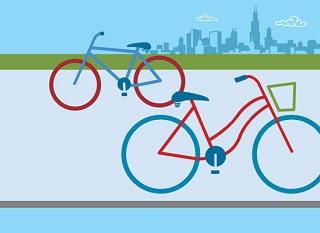Get yourself moving
Biking and walking are great ways to get to where you need to go while keeping fit.
Biking and walking daily are the perfect ways to save money on transportation while you exercise, enjoy the outdoors and improve your own health. The exercise you do on the way to your destination may increase your focus and productivity, reduce stress and make you feel refreshed and energetic.
Bicycle and pedestrian advocacy and resources
Active Transportation Alliance is a coalition of people who are working to make biking, walking and transit commutes safe, convenient and fun.
For a great source of bike information and safety tips, visit www.activetrans.org
Everyday Biking Guide: http://activetrans.org/sites/files/Everyday_Biking.pdf
Bike Rules of the Road: https://www.cyberdriveillinois.com/publications/pdf_publications/dsd_a143.pdf
Chicago's bike sharing system
Divvy is Chicago's bike sharing system which launched June 2013. The collaborative program is overseen by Chicago's Department of Transportation. The city owns the equipment and stations while the firm Motivate operates the program which is sponsored by Blue Cross and Blue Shield of Illinois.
Gain access to a bike with a Divvy membership. Sign up at www.divvybikes.com.
Bike or walk together
- Create an account to find other commuters and message the individuals that you match to about biking or walking together
- Contact staff to create a flyer outlining your commute. In addition to you having your own personal set of flyers, Pace RideShare will share your commute via social media, and at your employer's location when possible
- You may want to approach the Human Resources department, Transportation Coordinator or Property Manager for assistance with identifying other commuters that might be interested in biking or walking with you
Walking Safety Tips
Make sure you are staying as safe as possible by following these tips:
- Focus on the traffic. Don't get distracted with talking, texting and listening to tunes.
- When walking where there are no sidewalks, face oncoming traffic and use the shoulder area.
- Stay as far left of the lane as possible to give yourself time to respond to any dangers.
- Keep checking for traffic even when you have the right of way and are in crosswalks.
- Look out for vehicles turning into the intersection.
- When crossing a street, make eye contact with the drivers at the intersection. Look left-right-left.
- Only cross the street when all traffic is stopped
- When crossing multiple lanes of traffic, don't assume that all the lanes of traffic will stop.
- Walk defensively. Assume that drivers can not see you especially at dusk.
- At night, dress to be seen. Wear reflective gear and light colors. Carry a light.
